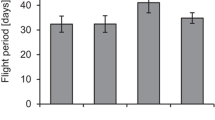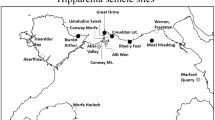Abstract
The minimum area requirement (MAR) of a species is the amount of functional habitat necessary for population persistence. The accurate measurement of MAR in the field usually requires long and precise investigations of all resources used by the target organism. Here we tested if MAR could be predicted by body size and species-specific life-history traits. Using values of MAR collected on European butterflies, we related MAR to 17 life-history traits plus wing size (a correlate of body size). We show that four life-history traits and wing size were significantly related with MAR in European butterflies. Compared to a model with wing size only, the inclusion of these four traits (myrmecophily, thermal tolerance, mate searching strategy, and ovigeny) more than doubled the power of the predictions of MAR. Our study provides a first step towards a predictive theory of species spatial requirements, with strong applications in conservation biology.

Similar content being viewed by others
References
Anderson DR, Burnham KP, White GC (1994) AIC model selection in overdispersed capture-recapture data. Ecology 75:1780–1793
Baguette M, Schtickzelle N (2006) Negative relationship between dispersal distances and demography in butterfly metapopulations. Ecology 87:648–654
Barton K (2012) MuMIn: multi-model inference R package version 166. http://CRANR-projectorg/package=MuMIn
Biedermann R (2003) Body size and area-incidence relationships: is there a general pattern? Glob Ecol Biogeogr 12:381–387
Bink FA (1992) Ecologische Atlas van de Dagvlinders van Noord-West Europa. Schuyt, Co., Haarlem
Blake JG (1983) Trophic structure of bird communities in forest patches in east-central Illinois. Wilson Bull 95:416–430
Bolnick DI, Svanbäck R, Fordyce JA, Yang LH, Davis JM, Hulsey CD, Forister MI (2003) The ecology of individuals: incidence and implications of individual specialization. Am Nat 161:1–28
Bowman J (2003) Is dispersal distance of birds proportional to territory size? Can J Zool 81:195–202
Bowman J, Jaeger JAG, Fahrig L (2002) Dispersal distance of mammals is proportional to home range size. Ecology 83:2049–2055
Brown JH, Marquet PA, Taper ML (1993) Evolution of body size: consequences on an energetic definition of fitness. Am Nat 142:573–584
Calder WA (1996) Size, function and life history. Dover, New York
Cizek L, Fric Z, Konvicka M (2006) Host plant defences and voltinism in European butterflies. Ecol Entomol 31:337–344
Dennis R, Shreeve T, Van Dyck H (2003) Towards a resource-based concept for habitat: a butterfly biology viewpoint. Oikos 102:417–426
Fahrig L (2001) How much habitat is enough? Biol Conserv 100:65–74
Forman RTT, Galli AE, Leck CF (1976) Forest size and avian diversity in New Jersey woodlots with some land use implications. Oecologia 26:1–9
Galli AE, Leck CF, Forman RTT (1976) Avian distribution patterns in forest islands of different size in central New-Jersey. Auk 93:356–364
Gilpin E, Soulé ME (1986) Minimum viable populations: processes of species extinction. In: Soulé M (ed) Conservation biology: the science of scarcity and diversity. Sinauer, Sunderland, pp 19–34
Grafen A (1989) The phylogenetic regression. Philos Trans R Soc B Biol Sci 326:119–157
Grömping U (2006) Relative importance for linear regression in R: the package relaimpo. J Stat Softw 17:1–27
Groves CR, Jenses DB, Valutis LL, Redford KH, Shaffer ML, Scott M, Baumgartner JV, Higgins JV, Beck MW, Anderson MG (2002) Planning for biodiversity conservation: putting conservation science into practice. Bioscience 52:499–512
Hanski I (1998) Metapopulation dynamics. Nature 396:41–49
Hanski I (1999) Metapopulation ecology. Oxford University Press, Oxford
Hanski I (2001) Spatially realistic theory of metapopulation ecology. Naturwissenchaften 81:372–381
Keogh JS, Scott IAW, Hayes C (2005) Rapid and repeated origin of insular gigantism and dwarfism in Australian tiger snakes. Evolution 59:226–233
Koojman SALM (2000) Dynamic energy and mass budget in biological systems. Cambridge University Press, Cambridge
Lafranchis T (2004) Butterflies of Europe. Diatheo, Paris
Lindeman RH, Merenda PF, Gold RZ (1980) Introduction to bivariate and multivariate analysis. Scott, Foresman and Co., Glenview
Lindstedt SL, Miller BJ, Buskirk SW (1986) Home range, time, and body size in mammals. Ecology 67:413–418
McNab BK (1963) Bioenergetics and the determination of home range size. Am Nat 97:133–140
Mueller T, Fagan WF (2008) Search and navigation in dynamic environments—from individual behaviors to population distributions. Oikos 117:654–664
Orme D, Freckleton R, Thomas G, Petzoldt T, Fritz S, Isaac N (2011) Caper: comparative analyses of phylogenetics and evolution in R R package version 04. http://CRANR-projectorg/package=caper
Peters RH (1983) The ecological implications of body size. Cambridge University Press, Cambridge
Pianka ER (1974) Evolutionary ecology. Harper and Row, New York
Pierce NE, Braby MF, Heath A, Lohman DJ, Mathew J, Rand DB, Travassos MA (2002) The ecology and evolution of ant association in the Lycaenidae (Lepidoptera). Annu Rev Entomol 47:733–771
Reed DH, O’Grady JJ, Brook BW, Ballou JD, Frankham R (2003) Estimates of minimum viable population sizes for vertebrates and factors influencing those estimates. Biol Conserv 113:23–34
Savage VM, Gillooly JF, Brown JH, West GB, Charnov EL (2004) Effects of body size and temperature on population growth. Am Nat 163:429–441
Sinervo B, Clobert J (2008) Life-history strategies, multidimensional trade-offs and behavioural syndromes. In: Danchin E, Giraldeau LA, Cezilly F (eds) Behavioural ecology, Oxford University Press, Oxford
Stevens VM, Turlure C, Baguette M (2010a) A meta-analysis of dispersal in butterflies. Biol Rev 85:625–642
Stevens VM, Pavoine S, Baguette M (2010b) Variation within and between closely related species uncovers high intra-specific variability in dispersal. PLoS One 5:e11123
Stevens VM, Trochet A, Van Dyck H, Clobert J, Baguette M (2012) How is dispersal integrated in life histories: a quantitative analysis using butterflies. Ecol Lett 15:74–86
Stevens VM, Trochet A, Blanchet S, Moulherat S, Clobert J, Baguette M (in press) Dispersal syndromes and the use of life-histories to predict dispersal. Evol Appl
Tammaru T, Haukioja E (1996) Capital breeders and income breeders among lepidoptera: consequences to population dynamics. Oikos 77:571–574
Thomas CD (1990) What do real population dynamics tell us about minimum viable population sizes? Conserv Biol 4:324–327
Traill LW, Bradshaw CJA, Brook BW (2007) Minimum viable population size: a meta-analysis of 30 years of published estimates. Biol Conserv 139:159–166
Turlure C, Schtickzelle N, Van Dyck H, Baguette M (2009) Resource-based habitat definition, niche overlap and conservation of two sympatric glacial relict butterflies. Oikos 118:150–160
Turlure C, Choutt J, Van Dyck H, Baguette M, Schtickzelle N (2010) Functional habitat area as a reliable proxy for population size: case study using two butterfly species of conservation concern. J Insect Conserv 14:379–388
Vos CC, Verboom J, Opdam PFM, Ter Braak CJF (2001) Toward ecologically scaled landscape indices. Am Nat 157:24–41
Wenny DG, Clawson RL, Faaborg J, Sheriff SL (1993) Population density, habitat selection and minimum area requirement of three forest-interiors warblers in central Missouri. Condor 95:968–979
Wickman PO, Garcia-Barros E, Rappe-George C (1995) The location of landmark leks in the small heath butterfly, Coenonympha pamphilus: evidence against the hot-spot model. Behav Ecol 6:39–45
Acknowledgments
We acknowledge funding from the EU FP7 SCALES project (“Securing the conservation of biodiversity across Administrative levels and spatial, temporal and Ecological Scales”; project no. 226852). This work is part of the “Laboratoire d’Excellence” (LABEX) entitled TULIP (ANR-10-LABX-41). We received very interesting comments from two reviewers that helped us to improve our manuscript.
Author information
Authors and Affiliations
Corresponding author
Electronic supplementary material
Below is the link to the electronic supplementary material.
Rights and permissions
About this article
Cite this article
Baguette, M., Stevens, V. Predicting minimum area requirements of butterflies using life-history traits. J Insect Conserv 17, 645–652 (2013). https://doi.org/10.1007/s10841-013-9548-x
Received:
Accepted:
Published:
Issue Date:
DOI: https://doi.org/10.1007/s10841-013-9548-x




